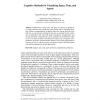Free Online Productivity Tools
i2Speak
i2Symbol
i2OCR
iTex2Img
iWeb2Print
iWeb2Shot
i2Type
iPdf2Split
iPdf2Merge
i2Bopomofo
i2Arabic
i2Style
i2Image
i2PDF
iLatex2Rtf
Sci2ools
DIAGRAMS
2008
Springer
2008
Springer
Cognitive Methods for Visualizing Space, Time, and Agents
Visualizations of space, time, and agents (or objects) are ubiquitous in science, business, and everyday life, from weather maps to scheduling meetings. Effective communications, including visual ones, emerge from use in the field, but no conventional visualization form has yet emerged for this confluence of information. The real-world spiral of production, comprehension, and use that fine-tunes communications can be accelerated in the laboratory. Here we do so in search of effective visualizations of space, time, and agents. Users' production, preference, and performance aligned to favor matrix representations with time as rows or columns and space and agents as entries. Both the diagram type and the technique have broader applications.
Artificial Intelligence | Conventional Visualization Form | DIAGRAMS 2008 | Effective Communications | Everyday Life |
| Added | 19 Oct 2010 |
| Updated | 19 Oct 2010 |
| Type | Conference |
| Year | 2008 |
| Where | DIAGRAMS |
| Authors | Angela M. Kessell, Barbara Tversky |
Comments (0)

